Top 10 Foods and Drinks High in Caffeine

Caffeine is a chemical naturally found in several plants used to make common foods and beverages, like coffee, tea, and chocolate. Supplemental forms of caffeine are also added to foods and beverages, such as sodas, candies, and energy drinks.
Caffeine is the most commonly consumed stimulant worldwide. (1) Although moderate levels of consumption may have health benefits, habitual use of high levels of caffeine can lead to physical dependence and even addiction. (2)
The health benefits of caffeine depend on the amount consumed and the health of the individual. (3) Research has found several potential benefits of moderate caffeine intake (not exceeding 4 cups of coffee or 400mg of caffeine per day), including a reduced risk of cancer, neurodegenerative diseases, and heart disease. (4,5)
Adverse side effects of too much caffeine include headache, migraine, insomnia, anxiety, and heart palpitations. (3,4) Certain groups, including pregnant women and small children, are advised to limit their intake of caffeine because it may cause negative effects, such as growth restriction and impacts on the developing nervous system. (3,6,7)
The upper intake limit (UL) of caffeine intake is 400mg for adults and less than 85mg for kids. (8)
Some of the highest caffeine foods and drinks include chocolate-covered coffee beans, coffee, energy drinks, espresso, sodas, green tea, black tea, dark chocolate, coffee liqueur, and baked goods containing chocolate.
For all these foods and drinks, the amount of caffeine listed here is an average number. The actual amount of caffeine can vary based on how strongly tea or coffee is brewed, and how much caffeine is added to various specific colas and energy drinks.
To find even more foods high in caffeine see the nutrient ranking of over 200 foods and drinks high in caffeine.
List of High Caffeine Foods and Drinks
-
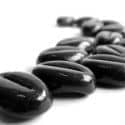 1. Dark Chocolate Coated Coffee Beans + Add
1. Dark Chocolate Coated Coffee Beans + Add
Caffeine
per oz(28 Beans)Caffeine
per 100gCaffeine
per 200 Calories336mg
(84% UL)839mg
(210% UL)311mg
(78% UL) -
 2. Coffee + Add
2. Coffee + Add
Caffeine
per 8oz CupCaffeine
per 100gCaffeine
per 200 Calories95mg
(24% UL)40mg
(10% UL)8000mg
(2000% UL) -
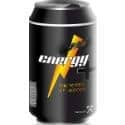 3. Energy Drinks + Add
3. Energy Drinks + Add
Caffeine
per 8oz CupCaffeine
per 100gCaffeine
per 200 Calories91mg
(23% UL)38mg
(10% UL)123mg
(31% UL)Energy drinks are typically high in sugar, sweeteners, and other artificial additives and should be avoided.
-
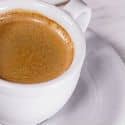 4. Espresso + Add
4. Espresso + Add
Caffeine
per 1oz ShotCaffeine
per 100gCaffeine
per 200 Calories63mg
(16% UL)212mg
(53% UL)4711mg
(1178% UL) -
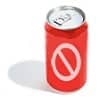 5. Sodas + Add
5. Sodas + Add
Caffeine
per 16oz BottleCaffeine
per 100gCaffeine
per 200 Calories49mg
(12% UL)10mg
(3% UL)49mg
(12% UL)Energy drinks are typically high in sugar, sweeteners, and other artificial additives and should be avoided.
-
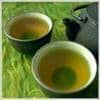 6. Green Tea + Add
6. Green Tea + Add
Caffeine
per 8oz CupCaffeine
per 100g28mg
(7% UL)12mg
(3% UL) -
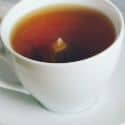 7. Black Tea + Add
7. Black Tea + Add
Caffeine
per 8oz CupCaffeine
per 100g26mg
(7% UL)11mg
(3% UL) -
 8. Dark Chocolate + Add
8. Dark Chocolate + Add
Caffeine
per 1oz SquareCaffeine
per 100gCaffeine
per 200 Calories24mg
(6% UL)86mg
(22% UL)30mg
(7% UL)- Cocoa powder provides 198mg of caffeine per cup
- Hot cocoa provides 5mg per cup
-
 9. Coffee Liqueur + Add
9. Coffee Liqueur + Add
Caffeine
per 1.5oz ShotCaffeine
per 100gCaffeine
per 200 Calories14mg
(3% UL)26mg
(7% UL)15mg
(4% UL) -
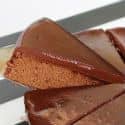 10. Chocolate Cake with Frosting + Add
10. Chocolate Cake with Frosting + Add
Caffeine
per SliceCaffeine
per 100gCaffeine
per 200 Calories8mg
(2% UL)6mg
(2% UL)3mg
(1% UL)Other baked goods containing caffeine include chocolate cake, chocolate-coated cookies, and anything with chocolate frosting.
Printable One Page Sheet
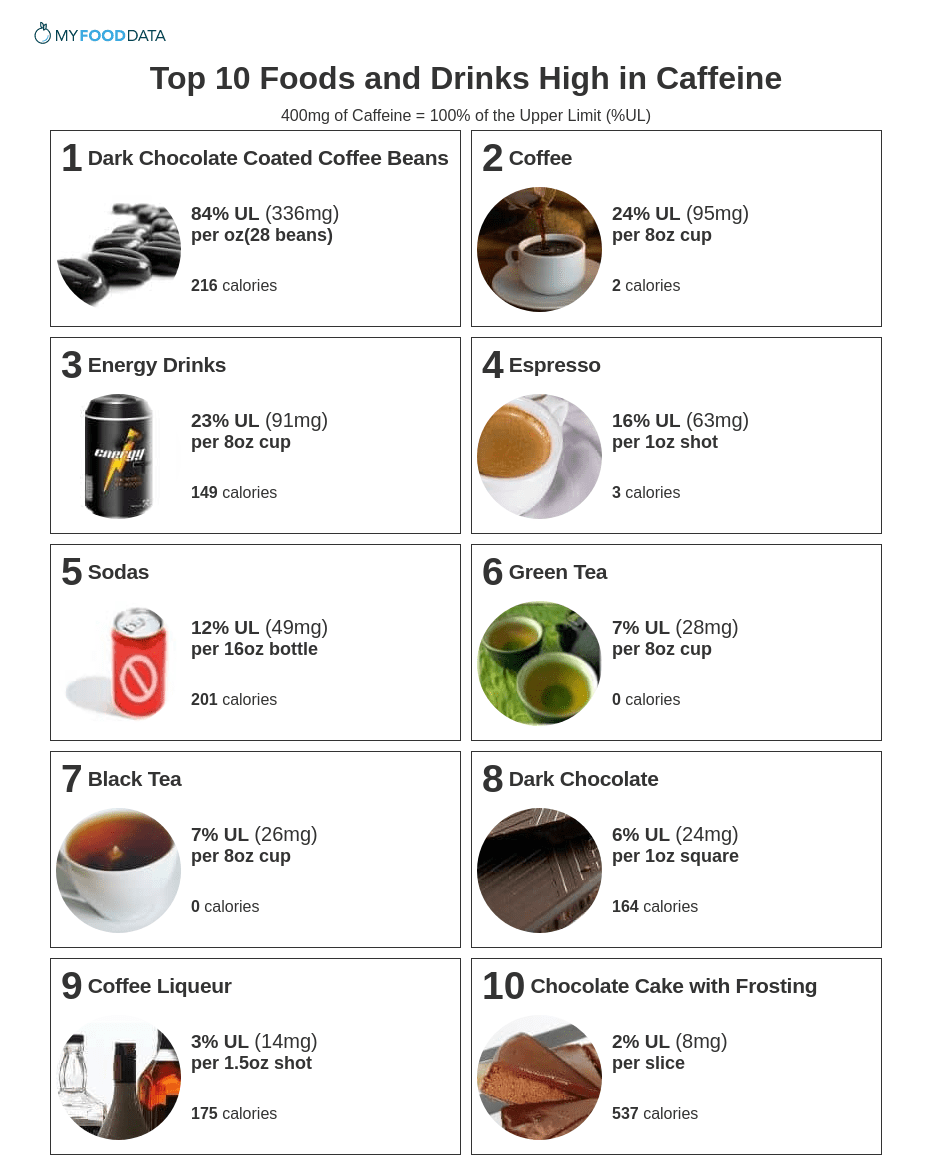
From the Nutrient Ranking Tool
Use the ranking tool links below to select foods and create your own food list to share or print.
- Foods High in Caffeine
- Foods Low in Caffeine
- Vegetarian Foods High in Caffeine
- Breakfast Cereals High in Caffeine
View more nutrients with the nutrient ranking tool, or see ratios with the nutrient ratio tool.
Related
Data Sources and References
- Abalo R. Caffeine and Its Antioxidant Properties-It Is All about Dose and Source Nutrients. 2021 Aug 24;13(9):2918. doi: 10.3390/nu13092918. 34578795
- Li S, Chen ML, Drucker AM, Cho E, Geng H, Qureshi AA, Li WQ. Caffeine addiction and determinants of caffeine consumption among health care providers: a descriptive national study JAMA Dermatol. 2018 Dec 1;154(12):1394-1400. doi: 10.1001/jamadermatol.2018.3301. 30347034
- Alamneh AA, Endris BS, Gebreyesus SH. Dietary sources, health benefits, and risks of caffeine PLoS One. 2020 May 8;15(5):e0232712. doi: 10.1371/journal.pone.0232712. eCollection 2020. 32384102
- Shahinfar H, Jayedi A, Khan TA, Shab-Bidar S. Coffee for Cardioprotection and Longevity Nutr Metab Cardiovasc Dis. 2021 Aug 26;31(9):2526-2538. doi: 10.1016/j.numecd.2021.05.014. Epub 2021 May 24. 34112583
- Santos RM, Lima DR. The Impact of Coffee on Health Eur J Nutr. 2016 Jun;55(4):1345-58. doi: 10.1007/s00394-016-1206-0. Epub 2016 Mar 30. 27026242
- Turner S, Ali A, Wham C, Rutherfurd-Markwick K. The Safety of Ingested Caffeine: A Comprehensive Review Nutrients. 2023 Feb 17;15(4):1011. doi: 10.3390/nu15041011. 36839369
- Hogervorst J, Virgolino A, Halldorsson TI, Vinceti M, Åkesson A, Leander K, Nawrot T, Filippini T, Laguzzi F. Association Between Maternal Caffeine Consumption and Metabolism and Neonatal Anthropometry: A Secondary Analysis of the NICHD Fetal Growth Studies-Singletons Environ Res. 2022 Oct;213:113705. doi: 10.1016/j.envres.2022.113705. Epub 2022 Jun 17. 35724727
- Cherniack EP, Buslach N, Lee HF. Caffeine in the Diet: Country-Level Consumption and Guidelines J Am Coll Nutr. 2018 Feb;37(2):161-167. doi: 10.1080/07315724.2017.1372822. Epub 2018 Jan 9. 29313749
Simplify Nutrition Tracking with MyFoodData!
Speedy Tools and Detailed Data FREEEasily analyze your meals to find the best foods for your goals.
✅ Use our recipe nutrition calculator and nutrition comparison tool.
✅ Access expert nutrition data tools and in-depth articles.
✅ Log foods and organize your recipes with a free account.


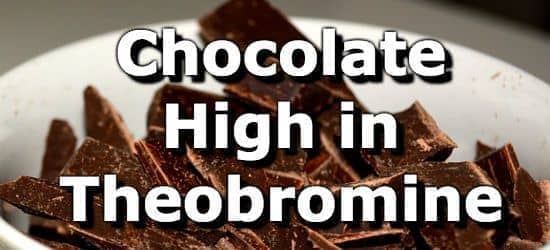 Next ➞
Next ➞
